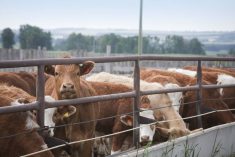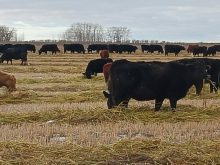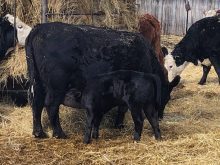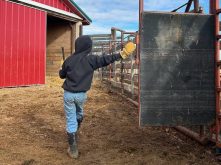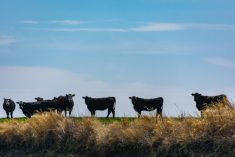After several months of a hot and dry summer, who would have imagined that we would have snow showers by the end of September. It wouldn’t have been so bad if some pastures had bounced back, yet they remain deplorable.
Of the many fall/winter pastures I have driven past or walked through, most show the signs of drought, namely short, high-fibre fields that I suspect are devoid of good nutrition for cattle, especially of trace minerals and vitamins.
Since they aren’t getting much out of the grass, I recommend to cow-calf producers implement a well-balanced mineral and vitamin program for their overwintering gestating cows. They could be rewarded with good cattle health, trouble-free pregnancies and a smooth calving season. Afterwards, it should help cows get ready for rebreeding and once again into calf.
Read Also

Harvest wraps up and fall work begins
At the Eppich famly ranch in western Saskatchewan, the fall harvest was successful with few breakdowns, cows and calves have been sorted and a new tractor has arrived
Consider the case of two Prairie operations, hundreds of miles apart, that I visited in the past year. One producer took my advice to implement a good cattle mineral-vitamin program and the other one continued on what he was doing for the past several years.
Each producer owns roughly 200 large-framed beef cows, which calve out in mid-March. Bulls are turned out the end of April, so both cow herds are pregnant by the beginning of summer. Each herd also had grazed drought-stricken pasture during the summer. The first producer was forced to supplement greenfeed by the summer’s end. The first owner feeds a fortified cattle mineral (with highly bioavailable trace minerals) all year-round, while the second producer sets out trace mineral salt blocks for most of the year and then buys a pallet of standard mineral just before the breeding season.
The biggest advantage of feeding a well-balanced cattle mineral assures the first producer his cow herd is receiving all their mineral and vitamin requirements. He might not realize that hot weather and drought not only reduce natural levels of essential minerals and vitamins in pasture grasses, but also could have long-term negative effects upon cattle mineral metabolism, well into autumn.
Cattle of poor mineral status often suffer from biological ‘oxidative stress,’ which compromise their health because oxidative damage in cattle underlies many metabolic and pathogenic diseases. For example, selenium (along with vitamin E) is part of an enzyme called gluthionine peroxidase, converts destructive oxidative compounds called ‘free radicals’ into harmless molecules and as a result improve vital functions such as successful reproductive performance. We see it as cows that are readily cleaned after calving, rapid uterine involution and a quick return to fertile estrus.
Such dire warnings prevented by a good mineral-feeding program might not sway people like the second beef producer, because he feeds salt blocks ingrained with trace minerals (TM) as a lowest-cost option.
He might not realize that TM salt does not contain essential macrominerals such as calcium, phosphorus or magnesium, which are likely deficient in drought-stricken pastures and even in lush fall regrowth. TM salt blocks also do not contain A, D and E vitamins, which are virtually nonexistent dried-out pastures, yet always essential for good cattle health, growth and reproduction. Plus, the nominal level of copper found in these salt blocks is no match against a pasture with a high molybdenum content (binds ingested copper in cattle) and proven to lead to copper deficiencies in cattle.
Getting back on track
Luckily, there is still plenty of time for the second producer to change his mind and implement a good mineral and vitamin program for his drought-affected cow herd. His plan should include:
- Purchase a commercial “breeder-” type cattle mineral, fortified with forage complementary levels of calcium and phosphorus with chelated forms of copper, zinc, manganese and selenium as well as high levels of vitamins A, D and E.
- Put cattle mineral in a well-made cattle mineral feeder. I prefer the two- or three- compartment feeder, covered with a rubber flap. I recommend that the feeder be mounted on a truck tire to it keep out of the mud and snow.
- Place mineral feeders (one per 25 animals) near water supply and salt (re: block).
- Fill mineral feeders with enough to be fed at the rate of three to four ounces per head per day.
- Check mineral feeders every few days to monitor intake. One common method to adjust mineral intake is to add some loose salt to the mineral.
It has been my understanding that both producers’ cow herds under better circumstances in previous years had similar conception and calving rates and health status. Although, the second producer did often have more mature cows with chronic retained placentas after calving and had a few others with delayed estrus, yet no significant problems were apparent. Maybe under this new plan, even the slightest improvement would be welcomed.





